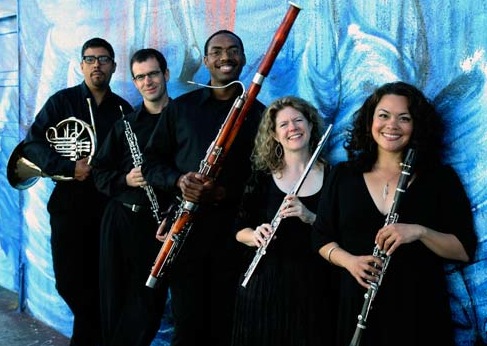Quinteto Latino, a woodwind quintet established by Armando Castellano to promote the music of Mexican composers, played a wide-ranging set May 3 at the Berkeley City Club. The home of Berkeley Chamber Performances, this quirky and elegant Julia Morgan-designed residence hall—where concrete structural elements arch into refined force diagrams like the bones and articulation of some exotic creature—creates a quintessential atmosphere. And something about the thoughtful programming and perky winds made it a particularly good fit.
They opened and closed the program off-book, lining up across the stage to serve up a jaunty Cuban dance as prelude and a slinky Argentinean tango as dessert. In between we heard more serious works, four modern Mexican composers.
Carlos Chávez was one of Mexico’s pioneering composers, applying classical training to native forms, including Yaqui songs and instruments and Aztec themes. In the 1930’s he helped promote electronic music, and those very different influences can be heard in his later works, including the Soli No. 2 on last Tuesday’s program.
Each of the five movements introduced a different instrument, with flutist Diane Grubbe holding forth in the Preludio. While her long notes descended a staircase the clarinet and bassoon laid down a bass underpinning. Then the flute spun back up, changing registers fluidly and hovering over found forms. As the oboe delivered an earnest passage Grubbe met Chávez’ challenge and went wild.
The Rondo put Kyle Bruckmann in the spotlight with bitten off oboe lines. The others repeated fragments of his runs, leaving gaps of erased passages. There was a sense of the arbitrary in the material, a flood field of silence around hills of notes. They flowed into the Aria, featuring guest bassoonist Rufus Olivier in a lovely solo, silvered notes on top and roguish punctuations on the bottom. Flute and clarinet held long notes together, a chance to show off their perfect tuning and then blend with French horn. The bassoon returned, a soliloquy on interval.
Hawaiian-born clarinetist Leslie Tagorda brought “pop” to the Sonatina, a romp where partners changed often in a motivic hall of mirrors. Then Tagorda returned with a full and thoughtful line, anchored by bassoon undertow. Armando Castellano used a French horn’s hefty timbre to develop thicker strands, grounding the harmonies. The flute reprised her slow opening descent, and then sharper discords met languorous horn notes, creating drama, and ending with that state of suspense.
Castellano introduced the next piece with his own history. He grew up in San Jose in a traditional Mexican household, travelling widely to watch his sisters celebrate folk dance. His favorite was when the women wore long white skirts and danced in the dark with lit candles on their heads. That piece was Son de la Bruja (Song of the Witch), arranged for this wind quintet by composer Jose Luis Hurtado.
Hurtado’s variations manage to be stately and lively, beginning with clarinet and flute at the bottom of their registers and then brightening with high flute cross-accents. Their full group sound overflowed the space.
After intermission they returned with Cinco Danzas Breves by Mario Lavista, and it was the most thought-provoking part of the program. After hearing their all-Lavista program in Trinity chapel in 2008, I was keenly looking forward to this. Lavista, like Chávez before him, informs his sound with both ancient instrumentation and electronics. He opens Molto allegro with springy rhythms, using a limited palette to rich effect. It had primitive energy and sophisticated work, subtle, bouncy and mysterious.
The Lento was bird-like in nature, with short questions answered by abrupt flowers of sound, all framed with delicate seamlessness. Then, in Andante, an obo
e’s sincerity floated over dense puffs, their flexible sympathy. In Adagio long golden chords showed a French horn’s gentle muscle. They broke apart and then brought their themes back together for a lingering chord, then went up-tempo for an energetic Presto.
We were sent home with the melodic Danza de Mediodía by Arturo Márquez, an opportunity to show their luster. Tagorda’s clarinet passages were so liquid and evenly weighted that they instilled weightlessness. Bruckmann brought feeling and lilt, and it was a pleasure to watch the “King of extended technique” sway to the sound. And Castellano was clean and forceful.
One sensed that their easy unison has been honed by their strenuous schedule: for the last three years they have played together nearly daily, bringing classical music into San Francisco’s many classrooms, part of the SF Symphony’s ambitious Adventures in Music program.
Along with their work in education comes a political/artistic partnership: composer Guillermo Galindo is currently writing a piece for them inspired by desert detritus, a sound tribute to border migrations, Voces del Desierto.
This concert ended the year for Berkeley Chamber Performances, but under the able direction of Joanne de Phillips the 2011 – 2012 season starts off with a bang. September 13 they star the Guirao-Howard-Dorman Trio in Jennifer Higdon’s high-energy Piano Trio, along with works by Brahms and Ravel.
—Adam Broner
Photo of Quinteto Latino from left: Armando Castellano, Kyle Bruckmann, Shawn Jones (replaced in this performance by associate-bassoonist Rufus Olivier), Diane Grubbe and Leslie Tagorda.
